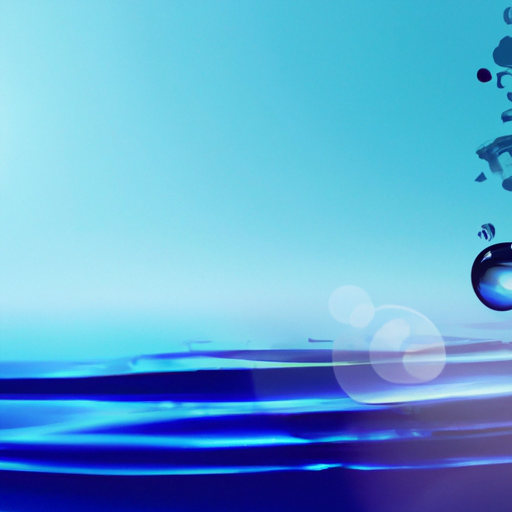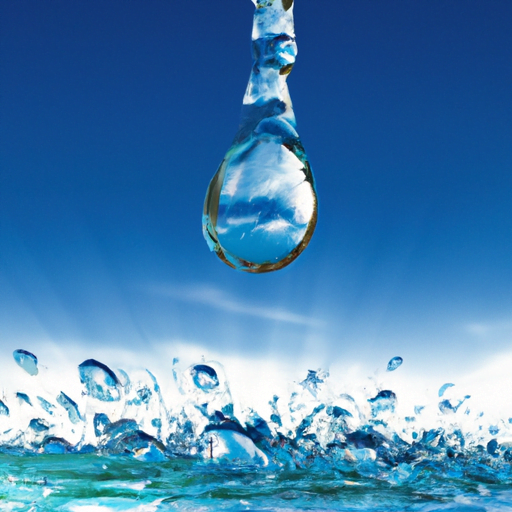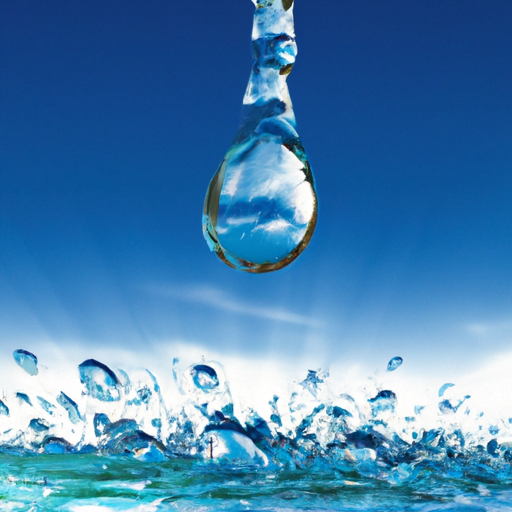Have you ever wondered if it’s possible to create water artificially? I mean, we all know that water is essential for life, but what if we could have a limitless supply of it, even in arid regions where water scarcity is a major issue? Well, today we’re going to dive into the fascinating world of artificially creating water and explore the potential it holds.
Living off-grid can be a dream for many, but it often comes with its own challenges, and access to water is certainly one of them. Traditional sources of water like rivers, lakes, and groundwater may not always be available in remote areas. However, scientists and engineers have been working tirelessly to find innovative solutions to tackle this problem. That’s where the concept of artificially creating water comes into play.
Artificially creating water involves replicating the natural process of water formation through various methods. One common technique is using dehumidifiers to extract water from the atmosphere. By cooling and condensing the air, these devices can collect water vapor and turn it into liquid water. Another approach is desalination, where saltwater is purified by removing the salt particles, making it suitable for drinking and irrigation. These advancements in technology are revolutionizing the way we think about accessing water and have the potential to benefit communities worldwide.
In the upcoming article, we’ll delve deeper into the different methods and technologies being developed to artificially create water. From atmospheric water generators to solar desalination plants, we’ll explore the science behind these innovations and discuss their advantages and limitations. So buckle up and get ready to learn more about the exciting potential of artificial water creation.

Exploring the Potential of Artificially Creating Water
Living off the grid can be a rewarding experience, allowing you to disconnect from the hustle and bustle of modern life and embrace a simpler, self-sufficient lifestyle. However, one of the major challenges faced by those living off the grid is access to water. In remote areas, water scarcity is a pressing issue that needs to be addressed. This is where the potential of artificially creating water comes into play.
Water as an Essential Resource
Water is essential for life. It is not only vital for our survival but also plays a crucial role in agriculture, industry, and ecosystem stability. However, access to clean and sufficient water remains a challenge for many people around the world. According to the World Health Organization (WHO), approximately 2.2 billion people do not have access to safe drinking water, and over 4.2 billion people lack basic sanitation services. This highlights the importance of finding innovative solutions to address the water crises.
The Need for Sufficient Access to Water
Living off the grid, whether it’s in a remote area or a sustainable community, presents unique challenges in terms of water availability. Remote areas often have limited or no access to water sources such as rivers, lakes, or reservoirs. This makes it difficult for individuals or communities to meet their daily water needs for drinking, cooking, hygiene, and irrigation.
Additionally, climate change and unpredictable weather patterns further exacerbate the challenges of water scarcity in these areas. Droughts, erratic rainfall, and extreme temperatures make it even more crucial to explore alternative methods of water creation to ensure sufficient access to this precious resource.
Understanding Artificial Water Creation
Artificial water creation refers to the process of producing water through methods other than natural sources. This entails using technology and scientific techniques to generate freshwater where it may not be readily available or to augment existing water supplies. Exploring and utilizing these methods can potentially help overcome water scarcity in remote areas and promote sustainability.
What is Artificial Water Creation?
Artificial water creation involves techniques such as desalination, cloud seeding, and water from air technology. These methods harness scientific principles to either extract freshwater from unconventional sources or enhance the natural water cycle to generate precipitation.
Exploring the Science Behind Artificial Water Creation
To understand the science behind artificial water creation, let’s delve deeper into each method and its underlying principles. By gaining insight into these processes, we can better appreciate their potential and limitations.
Methods Used in Artificial Water Creation
Desalination Techniques
Desalination is a process that removes salt and other impurities from seawater or brackish water, making it suitable for human consumption and irrigation. The most common desalination method is reverse osmosis, which uses a semi-permeable membrane to filter out salt ions, leaving behind freshwater.
This technique has been successfully implemented in many coastal areas around the world, providing a reliable source of freshwater. However, desalination plants require significant infrastructure and energy inputs, making them expensive to establish and maintain. Additionally, the disposal of the concentrated salt brine generated during the process has raised concerns about its impact on marine ecosystems.
Cloud Seeding
Cloud seeding involves introducing substances into the air to stimulate the formation of rain or snow within clouds. By dispersing chemicals such as silver iodide or dry ice, cloud condensation nuclei are created, enhancing the chances of precipitation. This method is primarily used in regions experiencing water scarcity or drought conditions.
While cloud seeding has shown promising results in some areas, its effectiveness is still a topic of debate among scientists. The complex nature of weather systems and the difficulty in measuring the direct impact of cloud seeding make it challenging to determine its true potential.
Water from Air Technology
Water from air technology, also known as atmospheric water harvesting, utilizes the humidity present in the air to produce freshwater. This method typically involves condensing the water vapor in the atmosphere, capturing it, and converting it into liquid form for use.
This technology has gained popularity in recent years due to its potential for decentralized water production. It can be particularly beneficial for off-grid communities or areas with low humidity levels. However, the energy requirements for this process and the limited water production capacity pose challenges that need to be addressed for widespread adoption.

Benefits and Potential of Artificial Water Creation
Increasing Water Availability
One of the primary benefits of artificial water creation is the potential to increase water availability in areas where it is scarce. By tapping into unconventional sources such as seawater or atmospheric moisture, communities can become less reliant on traditional water sources that may be limited or contaminated.
Enhancing Agricultural Production
Agriculture accounts for a significant portion of water usage globally. By implementing artificial water creation methods, such as desalination or cloud seeding, farmers in remote areas can have access to water for irrigation purposes. This can help boost agricultural production, increase food security, and alleviate pressure on existing freshwater resources.
Mitigating Water Scarcity
Water scarcity is a global concern that requires innovative solutions. Artificial water creation methods offer a potential avenue for mitigating water scarcity by diversifying water sources and reducing reliance on limited freshwater reservoirs. By exploring these techniques further, we can develop more sustainable approaches to water management.
Sustainability and Environmental Concerns
Assessing the Environmental Impact
While artificial water creation methods offer promising solutions to water scarcity, it is crucial to consider their environmental impact. Desalination, for instance, requires large amounts of energy and can result in brine discharge that may harm marine ecosystems if not properly managed. Cloud seeding may also have unintended consequences on weather patterns and ecosystems.
To ensure the sustainability of artificial water creation, it is vital to assess and minimize the environmental footprint of these techniques. The development of more energy-efficient processes and the implementation of proper waste management strategies are key considerations in balancing water needs and environmental sustainability.
Balancing Sustainability and Water Needs
Achieving a balance between sustainable water management and meeting the growing water needs of communities is a complex task. While artificial water creation methods offer potential solutions, they should be viewed as part of a wider water management strategy that includes conservation, watershed management, and efficient use of existing water resources.
It is important to recognize that artificial water creation alone cannot solve the global water crisis. However, when integrated with other sustainable water practices, it can contribute to addressing water scarcity and promoting long-term water security.
Current Applications and Success Stories
Desalination Plants around the World
Desalination plants have been successfully implemented in various coastal areas with limited access to freshwater. Countries like Saudi Arabia, the United Arab Emirates, and Israel have made significant investments in desalination infrastructure, providing a reliable source of freshwater for their populations.
Cloud Seeding Projects
Cloud seeding projects have been carried out in many regions to enhance precipitation and alleviate water scarcity. China, for example, has implemented large-scale cloud seeding operations to increase rainfall in drought-prone areas. While the results are not always guaranteed, these projects demonstrate the potential effectiveness of cloud seeding techniques.
Water from Air Technology Implementations
Water from air technology has seen successful implementation in areas with low humidity levels, such as arid regions and small island communities. Companies and organizations have developed portable devices and systems that can extract moisture from the air, providing a decentralized source of freshwater for households and communities.
Challenges and Limitations in Artificial Water Creation
Cost and Infrastructure Challenges
One of the significant challenges in implementing artificial water creation methods is the cost and infrastructure requirements. Desalination plants, for instance, require substantial capital investments and continuous energy supply for operation. Developing the necessary infrastructure for cloud seeding or atmospheric water harvesting can also be costly, especially in remote areas.
Technological Limitations
While artificial water creation methods show promise, they are not without limitations. Desalination, for example, is energy-intensive and can have negative environmental impacts if not properly managed. Cloud seeding’s effectiveness is still uncertain, and its outcomes vary depending on weather conditions and other factors. Water from air technology is limited by low humidity levels and energy requirements.
Future Prospects and Research
Advancements in Artificial Water Creation
Ongoing research and advancements in technology are continuously improving artificial water creation methods. Scientists and engineers are working on developing more energy-efficient desalination processes, optimizing cloud seeding techniques, and enhancing the efficiency of atmospheric water harvesting systems. These advancements hold promise for making artificial water creation more sustainable and economically viable.
Exploring Novel Techniques
In addition to existing methods, researchers are exploring novel techniques for artificial water creation. These include solar-powered desalination, nanoparticle-based filtration systems, and bio-inspired water harvesting technologies. These emerging approaches have the potential to revolutionize the field of artificial water creation and address some of the current challenges.
Promising Areas of Research
Researchers are also focusing on developing improved modeling and forecasting techniques to enhance cloud seeding practices. By gaining more insights into the atmospheric processes involved, scientists hope to optimize cloud seeding efforts and increase their success rates.
Additionally, the study of natural water creation processes, such as fog harvesting and dew collection, provides inspiration for more sustainable and accessible methods of capturing water from the environment. These approaches, when combined with technology and engineering, can offer innovative solutions for water creation.
Conclusion
Exploring the potential of artificially creating water is essential in addressing the global water crisis and ensuring the availability of this vital resource. Living off the grid presents unique challenges in terms of water scarcity, making it even more crucial to consider innovative solutions. Artificial water creation methods, such as desalination, cloud seeding, and water from air technology, offer promising avenues for increasing water availability, enhancing agricultural production, and mitigating water scarcity.
However, achieving a balance between sustainable water management and meeting the water needs of off-grid communities requires careful consideration of the environmental impact and limitations of these methods. Introducing artificial water creation as part of a comprehensive water management strategy, along with conservation efforts and efficient water use practices, can contribute to long-term water security.
Current applications and success stories around the world demonstrate the viability of artificial water creation methods. Desalination plants, cloud seeding projects, and water from air technology implementations offer hope for addressing water scarcity in various regions.
Despite the challenges and limitations, ongoing research and advancements in technology hold promise for improving artificial water creation methods. By exploring novel techniques and focusing on promising areas of research, we can continue to enhance our understanding of artificial water creation and its potential for a sustainable future.
Living off the grid poses unique challenges in terms of water accessibility, but by exploring the potential of artificial water creation, you can enhance your self-sufficiency and ensure a reliable water supply. From desalination to cloud seeding and water from air technology, there are various methods that offer possibilities for increasing water availability and mitigating water scarcity. Balancing sustainability and water needs should be a priority, considering the environmental impact of these methods. By integrating artificial water creation with conservation efforts and efficient use of existing resources, you can navigate the challenges of living off the grid while promoting long-term water security. So, can water be created artificially? The answer is a resounding yes, and it presents a wealth of opportunities for those looking to embrace a self-sufficient lifestyle.




